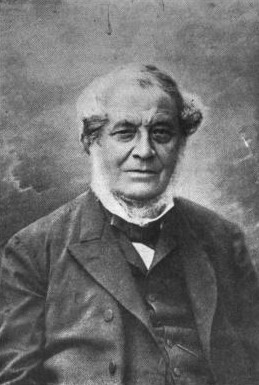- Robert Bunsen
Infobox_Scientist
box_width = 300px
name = Robert Bunsen
 |200px
|200px
image_width = 200px
caption =
birth_date = birth date|1811|3|31|df=y
birth_place =Göttingen ,Germany
death_date = death date and age|1899|8|16|1811|3|31|df=y
death_place =Heidelberg ,Germany
residence =Germany
nationality = German
field =Chemist
work_institutions = Polytechnic School of KasselUniversity of Marburg University of Heidelberg
alma_mater =University of Göttingen
doctoral_advisor =Friedrich Stromeyer
doctoral_students = nowrap|Adolf von Baeyer Fritz Haber Philipp Lenard Georg Ludwig Carius Adolph Wilhelm Hermann Kolbe Adolf Lieben Carl Friedrich Wilhelm Ludwig Viktor Meyer Friedrich Konrad Beilstein Henry Enfield Roscoe John Tyndall Edward Frankland Dmitri Ivanovich Mendeleev Thomas Edward Thorpe Francis Robert Japp
known_for = Discoveries ofcaesium andrubidium ;Bunsen burner , development of spectrochemical analysis
prizes =Copley medal (1860)
religion =
footnotes =Robert Wilhelm Eberhard Bunsen (31 March 1811 – 16 August 1899) was a German
chemist . He worked on emission spectroscopy of heated elements, and withGustav Kirchhoff he discoveredcaesium andrubidium . Bunsen developed several gas-analytical methods, he was a pioneer in photochemistry, and he did early work in the field oforganoarsenic chemistry. With his laboratory assistant,Peter Desaga , he developed theBunsen burner , an improvement on the laboratory burners then in use. TheBunsen-Kirchhoff Award for spectroscopy is named after him and his colleague,Gustav Kirchhoff .Life and work
Bunsen was born in
Göttingen ,Germany . He was the youngest of four sons of theUniversity of Göttingen 's chief librarian and professor of modern philology,Christian Bunsen (1770–1837). [cite journal | author = | title = Professor Robert W. Bunsen | journal = The Journal of the American Chemical Society | year = 1900 | volume = 23 | pages = 89 – 107 | url = http://books.google.com/books?id=u9oBAAAAYAAJ&pg=RA1-PA89&dq=robert+bunsen+son&as_brr=1 | accessdate = 2007-09-11 ] After attending school inHolzminden , Robert Bunsen studied chemistry. During this time, he met Friedrich Runge (who discoveredaniline and in 1819 isolatedcaffeine ),Justus von Liebig inGießen , andAlexander Mitscherlich inBonn .Bunsen became a lecturer at Göttingen and began experimental studies of the (in)solubility of
metal salt s ofarsenous acid . Today, his discovery of the use ofiron oxide hydrate as a precipitating agent is still the best-knownantidote againstarsenic poisoning .In 1836, Bunsen succeeded
Friedrich Wöhler atKassel . Bunsen taught there for two years, and then accepted a position at theUniversity of Marburg , where he studiedcacodyl derivatives. Although Bunsen's work brought him quick and wide acclaim, cacodyl, is toxic, has a strong combustion in dry air. Bunsen almost died from arsenic poisoning, and an explosion with cacodyl cost him sight in his right eye. In 1841, Bunsen created theBunsen cell , using acarbon electrode instead of the expensive platinum electrode used inWilliam Robert Grove 'sGrove cell . In 1850 he taught at Breslau.In 1852, Bunsen took the position of
Leopold Gmelin at Heidelberg. There he usedelectrolysis to produce puremetals , such aschromium ,magnesium ,aluminium ,manganese ,sodium ,barium ,calcium andlithium . A ten-year collaboration withHenry Enfield Roscoe began in 1852, in which they studied the photochemical formation ofhydrogen chloride fromhydrogen andchlorine .Bunsen discontinued his work with Roscoe in 1859 and joined
Gustav Kirchhoff to study emission spectra of heated elements, a research area calledspectrum analysis . For this work, Bunsen and his laboratory assistant,Peter Desaga , had perfected a special gas burner by 1855, influenced by an earlier one ofMichael Faraday . The newer design of Bunsen and Desaga is now called simply the "Bunsen burner ". [cite journal | last =Jensen | first =William B. | authorlink = | coauthors = | title =The Origin of the Bunsen Burner | journal = Journal of Chemical Education | volume = 82 | issue = 4 | pages = | publisher = | date =2005 | url = http://jchemed.chem.wisc.edu/HS/Journal/Issues/2005/Apr/clicSubscriber/V82N04/p518.pdf | doi = | id = | accessdate =] [See Michael Faraday's "Chemical Manipulation, Being Instructions to Students in Chemistry" (1827)]When Bunsen retired at the age of 78, he shifted his work solely to
geology andmineralogy , an interest which he had pursued throughout his career. He died inHeidelberg , and was buried there.For further reading
* [http://books.google.com/books?id=0RwWzUysftEC&pg=PA1&dq=Bunsen+Robert&as_brr=1#PPR3,M1 "Gasometry: Comprising the Leading Physical and Chemical Properties of Gases"] by Robert Bunsen (1857) London: Walton and Maberly (translated by Henry Roscoe)
* "Robert Wilhelm Bunsen", G. Lockeman, 1949.
* Sir Henry Roscoe's "Bunsen Memorial Lecture," "Trans. Chem. Soc.", 1900, reprinted (in German) with other obituary notices in an edition of Bunsen's collected works published by Ostwald and Bodenstein in 3 vols. at Leipzig in 1904.
*
Notes and references
External links
* [http://www.woodrow.org/teachers/ci/1992/Bunsen.html Robert Wilhelm Bunsen]
* [http://www.chemheritage.org/classroom/chemach/periodic/bunsen-kirchhoff.html Bunsen and Kirchhoff]
* [http://www.nndb.com/people/900/000095615/ Robert Wilhelm Bunsen]Persondata
NAME= Bunsen, Robert
ALTERNATIVE NAMES=
SHORT DESCRIPTION=Chemist
DATE OF BIRTH= 31 March 1811
PLACE OF BIRTH=Göttingen ,Germany
DATE OF DEATH= 16 August 1899
PLACE OF DEATH=Heidelberg ,Germany
Wikimedia Foundation. 2010.
